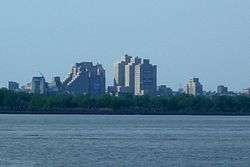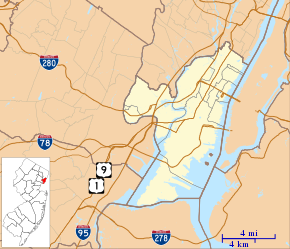Beacon, Jersey City
The Beacon is a mixed-use development located on a 14-acre (57,000 m2) site on Bergen Hill, a crest of the Hudson Palisades and one of the highest geographical points in Jersey City, Hudson County, New Jersey, United States. The Beacon, which occupies the Jersey City Medical Center's rehabilitated original complex, creates the northeastern corner of the Bergen Lafayette Section and is just east of McGinley Square. The Beacon includes 2,000,000 square feet (190,000 m2) of residential and retail space, approximately 1,200 luxury residences and 80,000 square feet (7,400 m2) of retail space.[3]
Jersey City Medical Center | |
 From the harbor | |
 | |
| Location | Roughly bounded by Montgomery Street, Cornelison Avenue, Dupont Street and Clifton Place, and Baldwin Avenue, Jersey City, New Jersey |
|---|---|
| Coordinates | 40°43′20″N 74°3′51″W |
| NRHP reference No. | 85003057[1] |
| NJRHP No. | 1515[2] |
| Significant dates | |
| Added to NRHP | November 27, 1985 |
| Designated NJRHP | March 19, 1985 |
Jersey City Medical Center moved to the site in 1882, and the complex was expanded in stages through the mid-20th century. Metrovest Equities was designated the redeveloper of the property in the first decade of the 21st century. The redevelopment stalled after a down-turn in the market,[4] but was completed by April 2016.[5]
The redeveloped complex, the largest concentration of Art Deco buildings in New Jersey, retains historical features of the exterior façades and public interior spaces. The complex is listed on the national and New Jersey registers of historic places.
History
The hospital began as the "Charity Hospital" by the Board of Aldermen of Jersey City who bought land at Baldwin Avenue and Montgomery Street in 1882 for a new hospital. The locale was chosen to remove the hospital from the industrial development at Paulus Hook. This building is now the Medical Center building. It was renamed the Jersey City Hospital in 1885 and had expanded to 200 beds. In 1909, the original hospital building was reserved for men and a second wing was added for women. When Frank Hague became mayor of Jersey City in 1917, he planned to expand the hospital. He had the original building renovated, and by the late 1920s started construction on a new 23-story structure for surgery. The new facility opened in 1931, and George O'Hanlon was the first director.
During the Great Depression, new buildings were added as a Works Progress Administration project secured by Mayor Frank Hague,[6] The Jersey City Medical Center included such architectural and designer trappings as marble walls, terrazzo floors, etched glass, decorative moldings and glittering chandeliers, and had one of the most famous maternity wards in the country – the Margaret Hague Maternity Hospital.[7] The original main hospital building was demolished to make way for two new hi-rise structures. The formal dedication of the Medical Center Complex, including the new B. S. Pollack Hospital building, was on October 2, 1936, with Franklin D. Roosevelt dedicating the building.
During the 1950s, JCMC was the home of the medical school of Seton Hall University, which later became the New Jersey Medical School, now located in Newark. Oversized and understaffed, in 1988[8] the Medical Center declared bankruptcy and became a private, non-profit organization. In 1994, the State of New Jersey designated the Medical Center as a regional trauma center, and in the late 1990s it was approved as a core teaching affiliate of Icahn School of Medicine at Mount Sinai. The hospital and offices moved to a new complex in 2004. Prior to that, one building of the complex, 591 Montgomery Street had been converted for senior assisted-living residence.
Metrovest Equities was designated the redeveloper of the property in 2003 and officially closed on it in 2005. The developer converted the ten federally landmarked, Art Deco buildings in the largest residential restoration project in the country and the largest in the history of New Jersey, with an expected cost estimated at $350 million.[9]
Use of existing infrastructure and restoration
The rehabilitation of The Beacon represents a massive recycling and adaptive reuse effort. The existing buildings are listed on the New Jersey Register of Historic Places and National Register of Historic Places,[10] and are the largest concentration of Art Deco buildings in the state. Unlike other proposals which had called for the demolition of the buildings, Metrovest intended to restore them to their original glory while simultaneously creating a viable new use using a team of craftsmen and historic preservationists to execute the restoration, which was performed under the Secretary of Interior's Guidelines for Historic Rehabilitation. This included rebuilding and restoring the buildings’ entire façades using the strictest of methods and materials, and restoring the protected interior spaces. A number of smaller low-rise buildings and utility structures were demolished throughout the complex over the years, and prior to total rehabilitation, especially in the area of Overlook Park, the new parking lots and the shuttle stop area.
Painstaking efforts to re-establish the historic grandeur and character of the interior spaces included refurbishing original chandeliers, plaster, decorative painting, marble, elevator door surrounds and windows that were re-gilded with gold leaf. Former Art Deco theaters, lobbies, public corridors, executive offices and meeting rooms were restored, with many of the spaces converted to elaborate amenity offerings for Beacon residents, including Mayor Hague's former office which now serves as a poker room.
The first buildings to be renovated were the Rialto and Capitol buildings, which now serve as residential condominiums and entertainment spaces. The restoration of these two buildings alone was estimated over $133 million and it took over four years to complete. In 2009, the New Jersey Department of Environmental Protection Historic Preservation Office awarded an Outstanding Contribution of Excellence Award[11] to the contractors and architects and others who participated in the restoration of the Rialto and Capitol buildings.[12]
Conversion
One building of the complex at 591 Montgomery Street had been converted for senior assisted-living residence before Metrovest's involvement. The company completed the conversion of the first two buildings by 2008. Named The Rialto and The Capitol after famous theaters, the buildings contain 315 condominium residences, joined by a two-story lobby and a 45,000-square-foot (4,200 m2) amenity core which features a gym, indoor pool, spa, screening room, and children's playroom. On the second floor are a restored theater/event space with catering kitchen and a rooftop sundeck. Other restored spaces include a poker room, reading gallery and a billiards hall. The next residential phase opened in 2012. The Mercury building features 126 rental residences. That was followed by the spring 2013 opening of The Orpheum, a 22-story, 158-unit rental building with one and two-bedroom residences offering 14-foot lofted ceilings. Construction continued on the parking garage that features a landscaped rooftop park with views of the Manhattan skyline, completed in late 2013. By early 2014 The Paramount building was next to be finished, with 20 stories of mainly one- and two-bedroom rental units, and its own gym. The final three buildings that were renovated were The Tower by late 2014, The Criterion in 2015, and The Hague by early 2016, all named after famous theaters.
Popular culture

The Beacon's existing buildings, particularly the former nurse's residence, formerly called Murdoch Hall, have often been used for filming movies, TV commercials and music videos, including the Robert Redford-directed Quiz Show starring John Turturro [13] and Stanley Tucci’s The Impostors.[14] Richard Price 1992 novel, Clockers, makes a thinly veiled reference to the abandoned Margaret Hague Maternity Hospital on Clifton Place. A "chronicler of Hudson County's underbelly", Price describes how vandals stripped the hospital interior of artifacts to be sold for scrap.[15]
See also
- List of neighborhoods in Jersey City, New Jersey
- List of Registered Historic Places in Hudson County, New Jersey
- Historic districts in Hudson County, New Jersey
- Whitlock Cordage
- Hudson and Manhattan Railroad Powerhouse
- Dixon Mills
| Preceded by 26 Journal Square |
Tallest Building in Jersey City The Orpheum 1931—1936 90m |
Succeeded by Jersey City Medical Center |
| Preceded by Jersey City Medical Center |
Tallest Building in Jersey City B.S. Pollack Hospital 1936—1989 98m |
Succeeded by Harborside Financial Center |
References
- Karschner, Terry (April 1981). "National Register of Historic Places Registration: Jersey City Medical Center" (PDF). National Park Service. Retrieved April 15, 2013. and accompanying 33 photos from 1960 to 1981.
- Historic Preservation Office (April 5, 2013). "New Jersey and National Registers of Historic Places: Hudson County" (PDF). New Jersey Department of Environmental Protection. p. 8. Archived from the original (PDF) on June 19, 2012. Retrieved April 15, 2013.
- Martin, Antoinette (February 27, 2005). "POSTINGS; A New Lease on Life For Jersey City Complex". The New York Times.
- "Once a modern marvel, Beacon of Jersey City sold after hitting rough times". NJ.com. Retrieved October 25, 2017.
- "Ex-Hague hospital officially reopens as Art Deco luxury apartments". NJ.com. Retrieved October 25, 2017.
- Golway, Tom (April 15, 2009), "W.P.A. Projects Left Their Stamp on the Region", The New York Times, retrieved October 6, 2011
- "Margaret Hague Maternity Hospital". www.NJCU.edu. Retrieved October 25, 2017.
- "Our History - Jersey City Medical Center - New Jersey". Barnabas Health. Retrieved October 25, 2017.
- "The New Deal's Lasting Legacy in Jersey City". JerseyCityIndependent.com. March 6, 2009. Archived from the original on March 5, 2012. Retrieved October 25, 2017.
- "National Register of Historical Places - NEW JERSEY (NJ), Hudson County". www.NationalRegisterOfHistoricPlaces.com. Retrieved October 25, 2017.
- "New Jersey Department of Environmental Protection". Historic Preservation Office of New Jersey. New Jersey Dept. Environmental Protection. 2009. Retrieved November 29, 2014.
- "Historic Renovation: The Beacon - Rialto & Capitol". Historic Renovation: The Beacon - Rialto & Capitol. Coco Architectural Grilles and Metalcraft. November 26, 2014. Retrieved November 29, 2014.
- Jerse City Past and Present Quiz Show location
- The Impostors on IMDb
- Strunsky, Steve. "Why Can't Hudson County Get Any Respect?; Despite Soaring Towers, Rising Property Values and Even a Light Rail, the Region Struggles to Polish Its Image" The New York Times, January 14, 2001
Further reading
- Vernon, Leonard F.; Metsch Jonathan M. (2004), Jersey City Medical Center, Arcadia Publishing, ISBN 9780738536644
- NJCU:Jersey City A to Z:JCMC
- USA Today: Model of Urban Future
- NY Times: Art Deco Grandeur Restored
